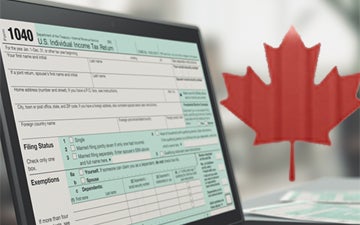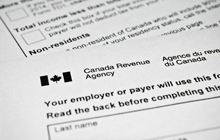Benefits of paperless processing for taxpayers: Lessons for CRA from the IRS

Canadian taxpayers will benefit if the CRA follows the IRS in the paperless processing of income tax returns but not at the expense of customer service
 |
David J Rotfleisch, CPA, JD is the founding tax lawyer of Taxpage.com and Rotfleisch & Samulovitch P.C., a Toronto-based boutique tax law corporate law firm. |
Cut processing times in half, reduce mistakes, expedite refunds by several weeks — and save 200M pieces of paper annually
The Internal Revenue Service in the United States launched a paperless processing initiative on August 8, 2023, aiming to “eliminate up to 200 million pieces of paper annually, cut processing times in half, and expedite refunds by several weeks.” The goal, per IRS Commissioner Danny Werfel, is to find new ways for the IRS to use technology to help taxpayers and to reduce errors resulting from manual inputs in recognition of the outdated processing system.
The initiative is established under the Inflation Reduction Act that went into effect in August 2022, which takes actions on clean energy and climate change. As a result of the initiative, taxpayers in the United States will be able to digitally submit all correspondence, non-tax forms, and responses to notices in the 2024 filing season. By 2025, the IRS will digitally process all paper-filed tax and information returns, as well as half of paper-submitted correspondence, non-tax forms, and notice responses.
The IRS also plans to digitize up to one billion historical documents with the goal of ultimately saving it approximately $40 million US in annual storage costs. This recent initiative has been called a “game-changer” for the IRS ,despite electronic filing having been permitted at least partially since the IRS e-file became operational nationwide in 1990. The IRS estimates that close to 95 oer cent of individual taxpayers will no longer need to send mail or submit documents in paper to the IRS.
Digitization of the tax filing system in Canada
Following the launch of the IRS e-file system, Canada started electronic filing in 1993 with EFILE, which has been only available to professional tax preparers. For individual taxpayers today, they mostly likely use NETFILE to file tax returns of recent years. Between February 7, 2023 and August 13, 2023, only 7.5% of the individual returns received by the CRA were not filed electronically. The growing trend of filing electronically increased during the COVID-19 pandemic and will likely continue into the future.
However, unless the CRA drops the long list of restrictions, there will always be a certain number of taxpayers who have to file their tax returns in paper. Currently, NETFILE services are not available for filing returns for any taxation year before 2017, taxpayers who went bankrupt in 2022 or 2023, non-residents and deemed residents, and taxpayers whose address is outside Canada.
One surprising downside of the prevalence of paperless processing in Canada is the growing inconvenience for taxpayers and tax practitioners. For example, since January 1, 2013, tax preparers who accept payment to prepare more than ten tax returns in a calendar year have been required to electronically file tax returns unless the tax filings meet certain legislative exceptions. Taxpayers who lack technical proficiency may also find themselves struggling with required tax forms and supporting documents.
The automatic tax filing pilot in Canada
Research has estimated that nearly one in ten Canadians do not file their taxes. In 2015 alone, the researchers estimated that the benefits these non-filers were otherwise entitled to was about $1.7 billion. As a result, integral to part of the efforts to make life more affordable by the Canadian government, the 2023 federal budget announced that the CRA will allow more Canadians to file their tax returns via File My Return Service.
The File My Return service allows Canadians with simple tax situations and lower or fixed income to auto-file their tax return over the phone upon receiving an invitation letter. The 2023 budget also disclosed a new automatic filing service in 2024, which aims to help vulnerable Canadians who currently do not file their taxes receive the benefits to which they are entitled. The federal government and the CRA have yet to release any specific plans regarding the new service.
Comparing the IRS initiative and current practices of the CRA: A consolidated system will be more efficient
Aiming to be more efficient, the IRS paperless processing initiative focuses on all aspects of communication between the IRS and taxpayers. Although the IRS has yet to release additional details on the platform to be used, it is likely that they will pursue a consolidated system to process tax and non-tax forms, correspondence, as well as other document submissions.
A consolidated or centralized system reduces likelihood of redundant processing and backlogs. For example, the Tax Court of Canada website allows taxpayers to file documents with the court electronically through a single portal as long as there is no sensitive personal information in the documents. The CRA system currently divides digital services into individual and business while having separate portals for representatives. For small business owners, having multiple accounts for their taxes can be burdensome without the help of experienced tax practitioners. It can be difficult for business owners to manage their CRA online accounts and to fulfill their filing obligations, especially if they have multiple businesses.
Learning from the IRS: Improvement of service should not exclude customer services
The increased trend of working from home has made it difficult for taxpayers to access phone and in-person customer services offered by the CRA. The federal government’s decision to lay off approximately 1,800 employees earlier this year has only made the telephone wait times longer. Despite the effort to improve customer service by showing estimated wait time on the CRA website, callers usually end up waiting much longer than the website’s estimate. Without a callback feature, callers have to keep waiting on the phone, listening to music on loop, for up to two hours.
There are taxpayers who have to update their personal information or talk to an agent over the phone. During tax filing seasons, the call centre is particularly important when the online system is down or under maintenance. To learn from the IRS initiative, the CRA should recognize the importance of alternatives to online services and allocate more resources to customer service. Especially taking the new automated filing service into consideration, the CRA will have to be ready for more inquiries from taxpayers who are working with the new system.
David J Rotfleisch, CPA, JD is the founding tax lawyer of Taxpage.com and Rotfleisch & Samulovitch P.C., a Toronto-based boutique tax law corporate law firm and is a Certified Specialist in Taxation Law who has completed the CICA in-depth tax planning course. He appears regularly in print, radio and TV and blogs extensively.
With over 30 years of experience as both a lawyer and chartered professional accountant, he has helped start-up businesses, cryptocurrency traders, resident and non-resident business owners and corporations with their tax planning, with will and estate planning, voluntary disclosures and tax dispute resolution including tax audit representation and tax litigation. Visit www.Taxpage.com and email David at david@taxpage.com.
Read the original article in full on Taxpage. Title image: iStock. Author photo courtesy Rotfleisch & Samulovitch P.C.










(0) Comments